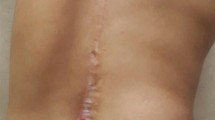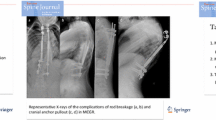Abstract
Purposes
Autofusion (AF) during growing rod (GR) instrumentation for early-onset scoliosis (EOS) has been reported, but AF incidence, causation, and clinical implications remain unknown. This article aims to (1) quantify frequency and severity of AF, (2) determine risk factors for AF, and (3) assess the influence of AF on final curve correction and spinal lengthening.
Methods
EOS patients were prospectively enrolled (2016–2021). Patients underwent evaluation, GR implantation, lengthenings, and posterior spinal fusion (PSF). Cobb angle and spinal length measurements were collected. AF was assessed and graded, with grades I–II being low-grade and III–V being high-grade. Exposure analysis quantified risk factors’ impact via odds ratios and Pearson regression correlates. Statistical significance was p ≤ 0.05 or ≥ 0.95.
Results
28 patients, with variable EOS diagnoses, were included. On average, GR were implanted at 8.54-year-old and lengthened over 4.66 years. 53.6% of patients received magnetically controlled GR (MCGR) and 46.4% traditional GR (TGR). The average construct bridged 13.4 levels. Over the lengthening period, for all indications, patients averaged 2.9 total open procedures. Curves corrected from 68.5º preoperatively to 35.3º after index GR to 35.6º after PSF. Spinal length increased from 30.0 cm preoperatively to 33.9 cm after index GR to 39.5 cm after PSF. AF grading was: 28.6% Grade I, 25.0% Grade II, 17.9% Grade III, 25.0% Grade IV, and 3.6% Grade V. Idiopathic EOS tended to have lower AF grades (p = 0.37). AF risk factors included GR age < 8 (10.4×, p = 0.01), any interval open procedures (6.3×, p = 0.05), and residual curve > 30º after index GR (13.7×, p = 0.02). Protective factors included preoperative spinal length of > 30.0 cm (0.11×, p = 0.01) and index MCGR (0.16×, p = 0.03). Maintenance of Cobb angles from index GR through PSF was relatively better in low-grade patients (p = 0.08). Spinal length gained was no different between low- and high-grade AF (p = 0.50).
Conclusions
This largest-to-date evaluation found AF is nearly ubiquitous in GR constructs, but with variable severity. Both risk factors and protective factors coincide with AF. Ultimately, even in high-grade AF, curve correction was maintained, and spinal lengthening was achieved.
Level of evidence
Level II—prospective cohort study.


Similar content being viewed by others
Data availability
The data that supports the findings of this study are available from the corresponding author, BM, upon reasonable request.
References
Yang S, Andras LM, Redding GJ et al (2016) Early-onset scoliosis: a review of history, current treatment, and future directions. Pediatrics. https://doi.org/10.1542/peds.2015-0709
Cahill PJ, Samdani AF (2012) Early-onset scoliosis. Orthopedics 35(12):1001–1003
Karol LA (2019) The natural history of early-onset scoliosis. J Pediatr Orthop. https://doi.org/10.1097/BPO.0000000000001351
Senkoylu A, Riise RB, Acaroglu E et al (2020) Diverse approaches to scoliosis in young children. EFORT Open Rev 5(10):753–762
Cunin V (2015) Early-onset scoliosis: current treatment. Orthop Traumatol Surg Res 101(1 Suppl):S109–S118
Hardesty CK, Huang RP et al (2018) Growing spine committee of the scoliosis research society. early-onset scoliosis: updated treatment techniques and results. Spine Deform 6(4):467–472
Goldberg CJ, Gillic I, Connaughton O et al (2003) Respiratory function and cosmesis at maturity in infantile-onset scoliosis. Spine (Phila Pa1976) 28(20):2397–2406
Bess S, Akbarnia BA, Thompson GH et al (2010) Complications of growing-rod treatment for early-onset scoliosis: analysis of one hundred and forty patients. J Bone Joint Surg Am 92:2533–2543
Akbarnia BA, Emans JB (2010) Complications of growth-sparing surgery in early onset scoliosis. Spine (Phila Pa 1976) 35(25):2193–2204
Moe JH, Kharrat K, Winter RB et al (1984) Harrington instrumentation without fusion plus external orthotic support for the treatment of difficult curvature problems in young children. Clin Orthop Relat Res 185:35–45
Mardjetko SM, Hammerberg KW, Lubicky JP et al (1992) The luque trolley revisited. review of nine cases requiring revision. Spine (Phila Pa 1976) 17(5):582–589
Fisk JR, Peterson HA, Laughlin R et al (1995) Spontaneous fusion in scoliosis after instrumentation without arthrodesis. J Pediatr Orthop 15(2):182–186
Cahill PJ, Marvil S, Cuddihy L et al (2010) Autofusion in the immature spine treated with growing rods. Spine (Phila Pa 1976) 35(22):E1199–E1203
Sankar WN, Skaggs DL, Yazici M et al (2011) Lengthening of dual growing rods and the law of diminishing returns. Spine (Phila Pa 1976) 36(10):806–809
Shaw KA, Bassett P, Ramo BA et al (2023) The evolving stall rate of magnetically controlled growing rods beyond 2 years follow-up. Spine Deform 11(2):487–493
Bouthors C, Izatt MT, Adam CJ et al (2018) Minimizing spine autofusion with the use of semiconstrained growing rods for early onset scoliosis in children. J Pediatr Orthop 38(10):e562–e571
Kohyama S, Yoshii Y, Okamoto Y et al (2022) Advances in bone joint imaging-metal artifact reduction. Diagnostics (Basel) 12(12):3079
Acknowledgements
The authors would like to acknowledge Nichole Leitsinger and Lindsay Schultz for their contributions to patient enrollment.
Funding
No funding was received for this project.
Author information
Authors and Affiliations
Contributions
Bryan Menapace: made substantial contributions to the conception or design of the work and made substantial contributions to the acquisition, analysis, or interpretation of data. Bryan Menapace: drafted the work and revised it critically for important intellectual content. Bryan Menapace, Viral Jain and Peter Sturm: approved the version to be published. Bryan Menapace, Viral Jain and Peter Sturm: agree to be accountable for all aspects of the work in ensuring that questions related to the accuracy or integrity of any part of the work are appropriately investigated and resolved. Viral Jain and Peter Sturm: made substantial contributions to the conception or design of the work. Viral Jain and Peter Sturm: revised the work critically for important intellectual content.
Corresponding author
Ethics declarations
Conflict of interest
Menapace: none, Jain: none, Sturm: Nuvasive and Green Sun Medical shareholder advisory board.
Ethical approval
This research study was conducted retrospectively from data obtained for research purposes. We consulted extensively with the IRB of Cincinnati Children’s Hospital Medical Center who determined that our study did not need ethical approval. An IRB official waiver of ethical approval was granted from the IRB at Cincinnati Children’s Hospital Medical Center.
Informed consent
IRB approved and attained from the parent and/or legal guardian at the time of study enrollment.
Additional information
Publisher's Note
Springer Nature remains neutral with regard to jurisdictional claims in published maps and institutional affiliations.
Rights and permissions
Springer Nature or its licensor (e.g. a society or other partner) holds exclusive rights to this article under a publishing agreement with the author(s) or other rightsholder(s); author self-archiving of the accepted manuscript version of this article is solely governed by the terms of such publishing agreement and applicable law.
About this article
Cite this article
Menapace, B., Jain, V. & Sturm, P. Autofusion in early-onset scoliosis growing constructs: occurrence, risk factors, and impacts. Spine Deform (2024). https://doi.org/10.1007/s43390-024-00853-8
Received:
Accepted:
Published:
DOI: https://doi.org/10.1007/s43390-024-00853-8




